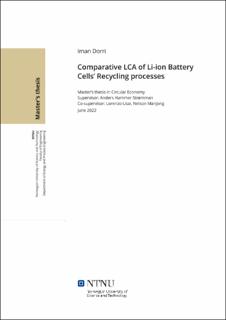| dc.description.abstract | Nowadays, lithium-ion batteries (LIBs) play a crucial role in the electric vehicles industry. Hence, they have been developed dramatically during the last decade worldwide. LIB cell is where the main components of a battery lie within it. Active cathode materials are one of the most important because they contain the most valuable materials of an LIB, such as cobalt, nickel, and manganese. LIBs also contain some hazardous materials, which in the case of leakage, can become a risk to humans and the environment. Therefore, it is important to manage spent LIBs properly. Recycling LIBs is the best solution to recover the valuable materials within LIBs, and also to prevent the risks that LIBs may cause. Pyrometallurgy and hydrometallurgy are the most common methods for recycling LIBs worldwide. Although pyrometallurgy can recycle LIBs independently, it needs a supplementary hydrometallurgical process to extract various materials separately. This study conducted a comparative LCA to assess the environmental impacts of a combined pyro- and hydrometallurgy method with an independent hydrometallurgy method. For this purpose, a comprehensive LCI and transparent model were created for each recycling method based on the thorough literature review carried out in the thesis. The lithium-nickel-manganese-cobalt oxide battery, also known as NMC, was selected as the recycling target of the intended recycling processes.
The LCA results demonstrated that hydrometallurgy is generally associated with higher environmental impacts, mainly due to more chemicals used in its different processes. Production of the chemicals causes high environmental burdens, and it has a significant influence on various environmental impact categories, including ozone depletion potential (ODP), global warming potential (GWP), and terrestrial acidification potential (TAP). Also, the hydrometallurgical process of the pyro- and hydrometallurgy method was the main source of environmental burdens caused by this recycling process. Thus, reducing the chemicals consumption and utilizing more environmentally friendly chemicals can be the most effective solution to reduce the environmental impact of the recycling processes investigated in this study. | |
